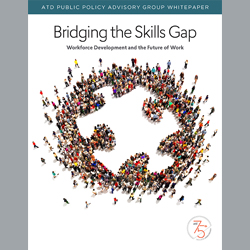Press Release
83 Percent of Organizations Have Skills Gaps, According to ATD Research
Wed Dec 19 2018

(ALEXANDRIA, VA), December 19, 2018—Companies are faced with increasing change, disruption, and market competition, and most of them have skills gaps that may threaten their ability to prepare for the future of work, according to a whitepaper just released by the Association for Talent Development’s (ATD) Public Policy Advisory Group.
The whitepaper, Bridging the Skills Gap: Workforce Development and the Future of Work, is ATD’s sixth skills gap report. The findings are based on a survey sent to 304 talent development professionals whose companies are headquartered in the United States.
Key findings from the report include:
Eighty-three percent of respondents report a skills gap in their organization and 78 percent expect their organizations will have a skills gap in the future. Almost three-quarters say that the skills gap affects their organization’s service delivery, customers, or future growth.
The biggest current and future gaps noted are in communication, critical thinking, and managerial and supervisory skills, showing that organizations need to focus on soft skills development programs.
Survey results show reason to be concerned about a succession planning crisis. It appears that organizations aren’t effective at preparing people for senior leader positions. Half of respondents said their companies had insufficient leadership bench strength, and 47 percent said they expect a gap of leadership or executive-level skills in the future.
Compared with data from ATD’s last survey in 2015, there has been a decrease in the percentage of companies offering internal training to help close the skills gap. The same is true of the percentage with internal certification programs. The percentage of companies offering offsite, vendor-provided training to employees and supporting enrollment in open, online courses has also dropped. This points to a disconnect—organizations say they want to shrink the skills gap but seem unwilling to dedicate the time and resources necessary to do so.
The talent development function has seen an increased role in addressing skills gaps since 2015, and there is now more accountability for individual managers. However, success in identifying and closing skills gaps depends on the involvement of key stakeholders across the organization.
Though government leaders have pushed for growth in apprenticeships, few respondents offer them. Most companies that do are in the skilled trades.
The whitepaper includes an action plan for talent development professionals that identifies six steps to assess and close skills gaps in their organizations.
Bridging the Skills Gap: Workforce Development and the Future of Work can be downloaded free at www.td.org/publicpolicy.
About ATD
The Association for Talent Development (ATD) is the world’s largest professional membership organization supporting those who develop the knowledge and skills of employees, improve performance, and help to achieve results for the organizations they serve. Originally established in 1943, the association was previously known as the American Society for Training & Development (ASTD).
ATD’s members come from more than 120 countries and work in public and private organizations in every industry sector. ATD supports talent development professionals who gather locally in volunteer-led U.S. chapters and international member networks, and with international strategic partners. For more information, visit www.td.org.
